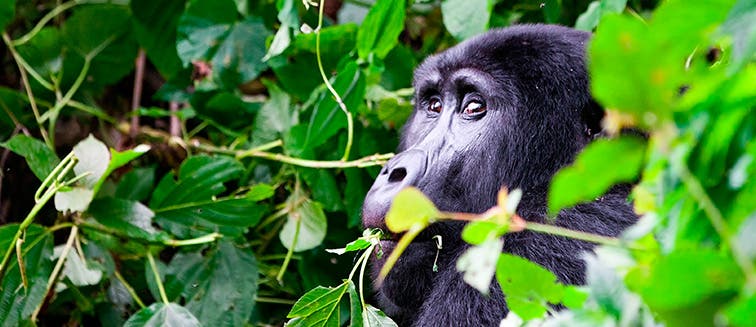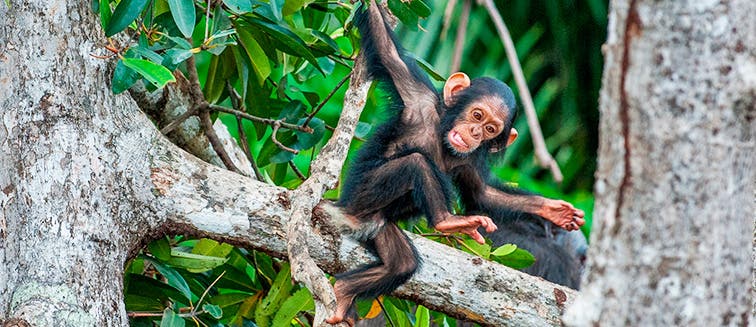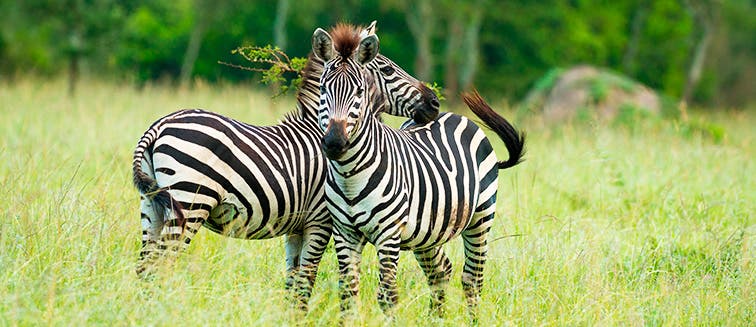For its modest size, Uganda packs a punch as a travel destination. Most choose a trip to Uganda to come face-to-face with its most mysterious and famous inhabitants: the mountain gorillas of Bwindi, but as the home of the much-contested source of the Nile and the tallest mountain range in Africa, the Rwenzoirs, there’s much to be discovered in Uganda. It’s also a top destination for tracking chimpanzees as well as a good choice for an African safari to see the Big Five. Winston Churchill called it the ‘Pearl of Africa’ and it’s easy to see why.
Stunning landscapes, wandering wildlife and welcoming locals make Uganda a destination not to be overlooked. As tourism is less well-established here you’ll be able to experience a slice of ‘true Africa’ on a trip to Uganda. Aside from the urban sprawl of the capital, Kampala, on the banks of Lake Victoria, Uganda is largely undeveloped. On a tour of Uganda, you’ll pass by picture-perfect terraced hillsides and dense forests as you explore the wild side of Africa. Situated between Kenya, South Sudan, the Democratic Republic of Congo, Rwanda and Tanzania, don’t miss out on visiting Uganda when you travel to East Africa.
History of Uganda
Understanding the history of Uganda is the best way to get to know the heart of the country and how it came to be the fascinating travel destination it is today. Hunter-gatherer communities and tribal groups were the original inhabitants of Uganda. In the 14th-15th centuries, the Empire of Kitara emerged as the first organised state in present-day Uganda, followed by the kingdoms of Buryoro-Kikara, Buganda, Toro, Akole and Busoga. In the 19th-century British explorers arrived in the kingdoms, on their search for the source of the Nile, marking the beginning of the Imperial British East African Company and eventually the Uganda Protectorate.
Uganda gained independence from Britain in 1962, leading to the abolition of the countries traditional kingdoms as it became a republic. In 1971, a military coup led by Idi Amin spelt the beginning of eight dark years in Uganda’s history. More than 100,000 Ugandans were murdered under the regime, in particular, those who had supported the former president. Furthermore, the large Asian population, many of which were entrepreneurs and business owners, were forcibly expelled during this era.
Such a huge loss of the population caused a decline in infrastructure and put a strain on the economy. In 1978 Amin’s forces invaded neighbouring Tanzania, sparking the Uganda-Tanzania War, which Uganda eventually lost when Kampala was captured the following year. Amin then fled the country. In 1986 political stability was restored under Yoweri Museveni, who remains the president to this day.
Nature in Uganda
Lying in the East African Plateau, Uganda is known for its fantastic natural attractions, such as Lake Victoria, one of the world’s largest lakes and an integral part of daily life for southern Ugandans. Above all else, a trip to Uganda is all about embracing the amazing natural environment and all the amazing sights and sounds that come with it. Murchinson Falls is one of the country’s top natural attractions. This national park is famous for its waterfall, where the Victoria Nile plunges over a massive drop in a spectacular display of the power of nature. River kayaking is a popular activity in the park, as well as day trips on the Nile river itself. Murchinson Falls is also home to a variety of wildlife, such as elephants, hippos and even lions. Bwindi Impenetrable National Park is, without a doubt, Uganda’s most desirable destinations.
It’s one of the best places in the world to see mountain gorillas in the wild. A number of gorilla ‘troops’ can be traced within these mist-shrouded mountains and tracking excursions are well worth the expense as expert guides help to guide travellers into the heart of the forest to watch the gorillas in their natural habitat. Queen Elizabeth National Park is a great choice for those looking for an authentic safari experience. Named after Queen Elizabeth, following her visit to Uganda in 1952, the park is similar to other game parks in East Africa but with a greater concentration of animals, ranging from lions to leopards, chimpanzees, hippos and the iconic Ugandan kob.
If you’re keen to see more of the country’s primate population on a tour of Uganda, you cannot miss out on a visit to Kibale National Park. This reserve is famous for its chimpanzee tracking excursions and is home to the highest concentration of primates in the world. It also plays host to a rich and diverse population of birdlife, making it a paradise for avid ‘twitchers’. Finally, if you’re the kind of adventurer that’s pulled to the mystery of the mountains, head to Rwenzori National Park which encompasses the Rwenzori mountain range and acts as a natural border between Uganda and the Democratic Republic of Congo. The highest peak is Mount Stanley, which stands at a staggering 5,109 metres tall.
Culture in Uganda
Due to the diverse range of ethnic groups living within Uganda, the national culture is complex and multi-faceted. In the north of the country, you can find groups such as the Lango, Acholi and Karamojong people, the latter of which is known for their livestock herding traditions. Elsewhere in Uganda, Bantu-speaking groups make up a large percentage of the population. The official languages are Swahili and English, although many different Bantu languages are spoken widely throughout the nation. Christianity is the largest religion and is also a considerable Muslim population, which can be traced back to connections made through East African trade routes during the 19th-century.
If you travel to Uganda you’ll encounter many opportunities to get to know the diverse local cultures. From witnessing the intricate ceremonial dances of Bwindi’s Batwa people, or getting to know the farming practices of local tribes, to discovering the ancient rock paintings of Nyero Rock and meeting urban Ugandans in a busy Kampala bar. There are many special cultural sites worth visiting on a tour of Uganda.
Visiting the ancient Buganda Tombs of Kasubi, the Basilica of the Uganda Martyrs or the sacred Sezibwa Falls can all reveal complex and fascinating elements of Ugandan culture. Coffee is another important part of Ugandan culture, and they make a stunningly good cup as well as growing the beans. On a trip to Uganda, it is worthwhile remembering that the country is relatively conservative and therefore visitors and locals alike are expected to dress modestly.
This beautiful country, known for its mountain gorillas, forests and the great Lake Victoria, is a haven for wildlife lovers and a paradise for any traveller who wants to experience unfiltered Africa. Authentic people, lively cities and untouched natural beauty, means a trip to Uganda needs to be top of your travel list.








